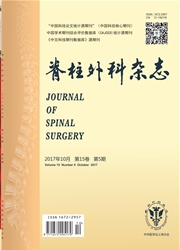

 中文摘要:
中文摘要:
目的探讨采用Zero—P椎间融合术治疗颈前路减压融合内固定术后相邻节段退变性疾病的疗效。方法对16例颈前路减压融合内固定术后发生相邻节段退变性疾病的患者采用Zero-P行颈前路椎间融合术,比较患者手术前后日本骨科学会(Japanese Orthopaedic Association,JOA)评分,观察患者术后吞咽困难发生情况及椎间融合情况。结果患者术后JOA砰分较术前提高,差异有统计学意义(P〈0.05),未发生吞咽困难,所有患者均获得牢固融合。结论采用Zero—P椎间融合术治疗颈前路融合术后相邻节段退变性疾病中短期疗效较好。
 英文摘要:
英文摘要:
Objective To investigate the clinical outcomes of Zero-P interbody fusion in the treatment of degenerative dis- ease at the adjacent segments afler anterior cervical decompression and fnsion with internal fixation. Methods Sixteen patients with degenerative diseases at adjacent segments after anterim' cervical deeompressinn and fusion with internal fixation received Zero-P anterio, cervical interbody fusion. Japanese Orthopaedic Association (JOA) scores were cmnpared before and after the operation. Postoperative dysphagia and intervertebral fusion were observed. Results Postoperative JOA score was signifieantly increased as compared with preoperative score (P〈 0.05 ). No dysphagia occurred a,ld all the patients nbtained solid fusion. Conclusion The mid- and short-term curative effect is satisfactory for the Zero-P intervertebral fusion in the treatment of cervical degenerative disease in the adjacent segments after anterior eervieal fasion.
 同期刊论文项目
同期刊论文项目
 同项目期刊论文
同项目期刊论文
 期刊信息
期刊信息
